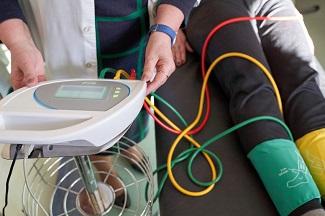Is This Wound Chronic?
March 29, 2019
Chronic wounds affect over 6.5 million people annually in the United States, with a total cost of over $26.8 billion per year.1 Proper identification of chronic wounds is necessary to develop an effective treatment plan, although many elements—such as intrinsic and extrinsic factors, comorbidities, and mixed etiologies—may complicate this process.2
Chronic Wound Assessment
When assessing a wound for chronicity, several factors should be taken into consideration, including:3
- Wound location
- Wound tissue type
- Periwound and wound edge shape
- Temperature
- Pulses
- Sensation
- Exudate color and amount
- Wound depth
- Duration
Wound chronicity is defined by the wound’s inability to progress through the repair cycle in a timely manner, and although there is no consensus for the time required for a wound to be labeled as chronic, a range of four weeks to three months is often cited.4 Generally speaking, when wound healing is impaired, there are multiple contributing factors. Non-healing wounds often display several similar characteristics, such as a high level of proteases, elevated inflammatory markers, reduced cellular proliferation, and low growth factor activity.5
Factors that Inhibit Wound Healing
Factors that commonly inhibit the healing process can include one or more of the following conditions:5
- Infection: Bacterial or foreign body infection can disrupt the processes along the wound healing continuum. The presence of necrotic tissue can indicate bacterial infection, and the presence of foreign bodies is often detected by the presentation as a draining sinus.
- Ischemic conditions: Ischemic conditions can often be seen in chronic wounds, such as arterial insufficiency, venous hypertension, and pressure injuries. Individual tolerance to ischemia can play an important role, with greater severity found in critically ill patients.
- Moisture: Excessive moisture, such as perspiration, does not directly cause pressure injuries, but it can impair healing and increase the risk for wound chronicity.
- Metabolic conditions: Several metabolic conditions contribute to wound chronicity, the most common of which is diabetes. Malnutrition can also inhibit wound healing and increase the risk of infection.
- Immunosuppression: Immunosuppressive agents frequently contribute to wound chronicity. Systemic immunosuppression from corticosteroids is especially common, although sirolimus and chemotherapeutic agents can also negatively impact healing.
- Radiation: Radiation and radiation injury both can delay wound healing.
Common Chronic Wounds
Common chronic wounds, as well as a brief overview of their characteristics, include the following:3
- Arterial ulcers: Typically found between or on the tips of toes or the outer ankle, these ulcers have a punched-out, round appearance with pale pink, gray, or yellow coloring and periwound edema. They are usually deep, full-thickness wounds, and patients generally experience pain.
- Venous ulcers: These wounds are generally on the gaiter area of the leg, above the malleolus to one inch below the knee, along the distal saphenous vein. They are generally an irregular shape, and edema is commonly present in the lower extremities. The tissue will be moist, viable red granulation tissue that may or may not slough. The depth is shallow, and the wound is diffuse.
- Diabetic neuropathic ulcers: Commonly found below the ankle, these ulcers are round with calloused edges. They are generally pink, pale, and dry with a partial- or full-thickness.
- Surgical dehiscence: This wound occurs when a surgical incision breaks apart along the suture and the edges start to separate rather than close.
- Atypical wounds: Atypical wounds have an unknown etiology and will frequently have an abnormal presentation or location.
- Pressure ulcers/injuries: These wounds commonly occur over bony prominences, under medical devices, or in mucosal membranes. They are usually irregular in shape, depending on the friction and shear, with varying colors and a depth that can range from intact to partial- or full-thickness.
Conclusion
The best way to prevent wound chronicity is to control the risk factors, which is not always possible. When wound chronicity is suspected, an accurate and timely diagnosis is crucial to develop a treatment plan that will lead to proper healing. A comprehensive treatment plan will account for all of the factors and comorbidities that have an impact on healing, and regular monitoring will help to ensure that progress is being made.
References
1. Padula WV, Delarmente BA. The national cost of hospital-acquired pressure injuries in the United States. International Wound Journal. 2019.
2. Gupta S, Andersen C, Black J, et al. A compendium of clinical research and practice management of chronic sounds: diagnosis, preparation, treatment, and follow-up. WOUNDS. 2017. https://www.woundsource.com/resource/wounds-compendium-clinical-researc…. Accessed February 20, 2019.
3. Carver C. Chronic wound identification and assessment. WoundSource. 2018. from https://pages.woundsource.com/chronic-wound-identification-and-assessme… . Accessed February 20, 2019.
4. American College of Surgeons Division of Education. Non-healing wounds. ACS/ASE Medical Student Core Curriculum. https://www.facs.org/~/media/files/education/core%20curriculum/nonheali…. Accessed February 20, 2019.
5. Ucciolo L, Izzo V, Meloni M, et al. Non-healing foot ulcers in diabetic patients: general and local interfering conditions and management options with advanced wound dressings. J Wound Care. 2015;24(4), 35–42.
The views and opinions expressed in this blog are solely those of the author, and do not represent the views of WoundSource, HMP Global, its affiliates, or subsidiary companies.












Follow WoundSource
Tweets by WoundSource